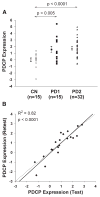Metabolic brain networks associated with cognitive function in Parkinson's disease
- PMID: 17113310
- PMCID: PMC4456012
- DOI: 10.1016/j.neuroimage.2006.09.003
Metabolic brain networks associated with cognitive function in Parkinson's disease
Abstract
The motor manifestations of Parkinson's disease (PD) have been linked to an abnormal spatial covariance pattern involving basal ganglia thalamocortical pathways. By contrast, little is known about the functional networks that underlie cognitive dysfunction in this disorder. To identify such patterns, we studied 15 non-demented PD patients using FDG PET and a voxel-based network modeling approach. We detected a significant covariance pattern that correlated (p<0.01) with performance on tests of memory and executive functioning. This PD-related cognitive pattern (PDCP) was characterized by metabolic reductions in frontal and parietal association areas and relative increases in the cerebellar vermis and dentate nuclei. To validate this pattern, we analyzed data from 32 subsequent PD patients of similar age, disease duration and severity. Prospective measurements of PDCP activity predicted memory performance (p<0.005), visuospatial function (p<0.01), and perceptual motor speed (p<0.005) in this validation sample. PDCP scores additionally exhibited an excellent degree of test-retest reliability (intraclass correlation coefficient, ICC=0.89) in patients undergoing repeat FDG PET at an 8-week interval. Unlike the PD-related motor pattern, PDCP expression was not significantly altered by antiparkinsonian treatment with either intravenous levodopa or deep brain stimulation (DBS). These findings substantiate the PDCP as a reproducible imaging marker of cognitive function in PD. Because PDCP expression is not altered by routine antiparkinsonian treatment, this measure of network activity may prove useful in clinical trials targeting the progression of non-motor manifestations of this disorder.
Figures




Similar articles
-
Abnormal metabolic pattern associated with cognitive impairment in Parkinson's disease: a validation study.J Cereb Blood Flow Metab. 2015 Sep;35(9):1478-84. doi: 10.1038/jcbfm.2015.112. Epub 2015 Jun 10. J Cereb Blood Flow Metab. 2015. PMID: 26058693 Free PMC article. Clinical Trial.
-
Changes in network activity with the progression of Parkinson's disease.Brain. 2007 Jul;130(Pt 7):1834-46. doi: 10.1093/brain/awm086. Epub 2007 Apr 30. Brain. 2007. PMID: 17470495 Free PMC article.
-
Distinct brain networks underlie cognitive dysfunction in Parkinson and Alzheimer diseases.Neurology. 2016 Nov 1;87(18):1925-1933. doi: 10.1212/WNL.0000000000003285. Epub 2016 Oct 5. Neurology. 2016. PMID: 27708130 Free PMC article.
-
Radionuclide brain imaging correlates of cognitive impairment in Parkinson's disease (PD).J Neurol Sci. 2011 Nov 15;310(1-2):31-5. doi: 10.1016/j.jns.2011.06.053. Epub 2011 Jul 16. J Neurol Sci. 2011. PMID: 21762928 Review.
-
[Functional imaging of deep brain stimulation in idiopathic Parkinson's disease].Nervenarzt. 2010 Oct;81(10):1204-7. doi: 10.1007/s00115-010-3027-3. Nervenarzt. 2010. PMID: 20798917 Review. German.
Cited by
-
Voxel-based meta-analysis of gray matter volume reductions associated with cognitive impairment in Parkinson's disease.J Neurol. 2016 Jun;263(6):1178-87. doi: 10.1007/s00415-016-8122-3. Epub 2016 Apr 25. J Neurol. 2016. PMID: 27113603
-
Recent Investigations on the Functional Role of Cerebellar Neural Networks in Motor Functions & Nonmotor Functions -Neurodegeneration.Curr Neuropharmacol. 2022;20(10):1865-1878. doi: 10.2174/1570159X20666220310121441. Curr Neuropharmacol. 2022. PMID: 35272590 Free PMC article. Review.
-
Metabolic networks for assessment of therapy and diagnosis in Parkinson's disease.Mov Disord. 2009;24 Suppl 2(0 2):S725-31. doi: 10.1002/mds.22541. Mov Disord. 2009. PMID: 19877247 Free PMC article. Review.
-
Functional brain networks in the evaluation of patients with neurodegenerative disorders.Nat Rev Neurol. 2023 Feb;19(2):73-90. doi: 10.1038/s41582-022-00753-3. Epub 2022 Dec 20. Nat Rev Neurol. 2023. PMID: 36539533 Review.
-
Low striatal glutamate levels underlie cognitive decline in the elderly: evidence from in vivo molecular spectroscopy.Cereb Cortex. 2008 Oct;18(10):2241-50. doi: 10.1093/cercor/bhm250. Epub 2008 Jan 29. Cereb Cortex. 2008. PMID: 18234683 Free PMC article.
References
-
- Aasland D, Zaccai J, Brayne C. A systematic review of prevalence studies of dementia in Parkinson’s disease. Mov Disord. 2005;20:1255–1263. - PubMed
-
- Army Individual Test Battery. Manual of Directions and Scoring. War Department, Adjutant General’s Office; Washington, DC: 1944.
-
- Alexander GE, Moeller JR. Application of the scaled subprofile model to functional imaging in neuropsychiatric disorders: a principal component approach to modeling brain function in disease. Hum Brain Mapp. 1994;2:1–16.
-
- Asanuma K, Ma Y, Huang C, et al. The metabolic pathology of dopa-responsive dystonia. Ann Neurol. 2005;57:596–600. - PubMed
Publication types
MeSH terms
Substances
Grants and funding
LinkOut - more resources
Full Text Sources
Medical

